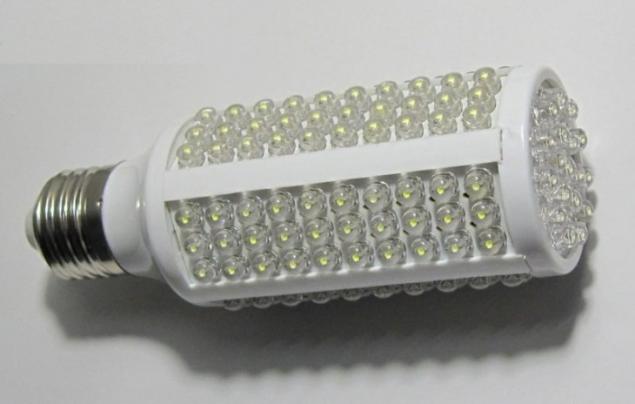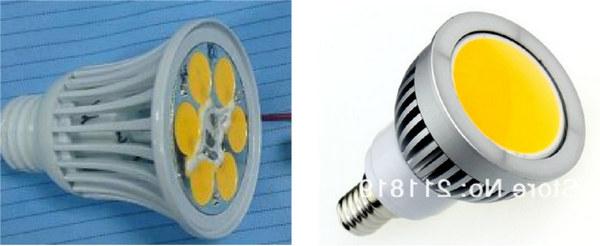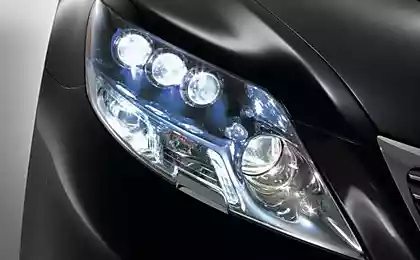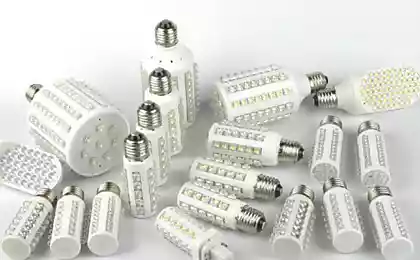1112
7 useful facts about LED lamps: how they work, how they work and how to choose them
Website published an article that details all the critical issues associated with LED lamps.

1. Why to buy LED lights? H2> Conventional light bulbs excellent light, but very energoneeffektivny - 95% of the energy they have transformed into heat. Fun fact: after the ban of the sale of light bulbs, more powerful 100 W, manufacturers, no matter how What had happened, continued to produce them, but called no lights, and the "radiant warmer" and in fact they are right.
2. LED and energy-saving lamps are one and the same? And if not, what is better? H2> Of course, the LED lamps can be considered energy-efficient, however, in the Russian language the word "saving" fixed for compact fluorescent lamps (CFLs) and CFL and LED lamps - not the same thing.
type LED bulb contains no hazardous substances, and the flask every CFL contains mercury; type LED lamp consumes less energy for the same light output; type LED lamp instantly ignited at full brightness, and the brightness of the CFL gradually gaining 20% to 100% per minute at room temperature and more slowly at low temperatures; Do CFL bad spectrum consisting of the peaks of several colors. The spectrum of the LED lamp is much closer to natural light and incandescent light. 3. What is it lit? H2> In 1923, the Soviet physicist Oleg Losev discovered electroluminescence semiconductor junction. The first LED using this principle and called - «Losev Light» (Losev light). First came the red LED, and then in the early '70s there were yellow and green LEDs. Blue LED was created in 1971 by Jacob Panchechnikovym, but it was extremely expensive. In 1990, the Japanese Sugi Nakamura created a cheap and bright blue LED.
4. What are the LED bulbs? H2> LED lamps are available in different packages with different types of caps. This conventional "pear", "candle" and "balls" with E27 base and E14, and "mirror" lamp R39, R50, R63 and spotlights with GU10 base and GU5.3, capsule lamps with G4 socket and G9, lamps ceilings with cap GX53.
5. Do I always have LED lamp can be simply screwed instead of the usual? H2> No, not always. There are two issues that you may encounter:
Work with a switch having LED. A large number of LED lamps can not work with switches that have indicator. They are poorly lit or flashes when the switch is turned off. This is due to the fact that the weak current is constantly flowing through the lamp. Out of this situation are two: either use the lamp works correctly with these switches on or off the LED inside the switch. Dimming. Most LED lamps can not work with dimmer (dimmer), but there are special dimmable LED lamps (usually they are much more expensive than usual). Unlike incandescent bulbs, with a decrease in the brightness of the LED lamp does not change the color of light (a normal lamp it turns yellow). Many dimmable LED lamps dimmed not up to scratch, but only up to 15-20% of full brightness. 6. Do all LED lamps are good and if not, what good are distinguished from the bad? H2> In conventional incandescent lamps simply everything: the bulb and tungsten filament. LED lamp is arranged much more complicated and its quality depends on the quality of LEDs, the phosphor and electronics.
Ripple light. Many substandard lights have a high ripple (flickering) light. Such light visually nekomforten and people quickly get tired of it. When looking from one subject to another visible strobe effect (visible as a few things instead of one). The human eye sees more than 40% ripple. There are two ways to check availability ripple of light - pencil test (take a normal long pen the tip and start very quickly to move them in a semicircle back and forth. If the individual contours of the pencil is not clear - the flicker there, and if seen "a few sticks" - the light blinks) and check with a camera phone (if you look at the light through a smartphone camera, usually when a glimmer of light on the screen will go to the strip, with what they are brighter, the stronger flicker). Lamps with apparent surge can not be used in residential areas. The color rendering index (CRI). The spectrum of light LED lamp differs from the spectrum of sunlight and incandescent lamp light. Though light and it appears white, some color components in it more, some less. CRI indicates how uniform level of different color light components. At low CRI less visible light shades. Such light is visually unpleasant, And understand that it is not so very difficult. Incandescent sun and CRI = 100, conventional LED lamps it is more than 80, have a very nice big lamps 90. CRI below 80 in dwellings should be avoided. < Lighting angle. LED lamp type "pear" are of two kinds. At first the protective cap has a hemispherical shape having the same diameter as the body. These lamps do not shine back and if they shine down the chandelier, the ceiling will remain dark, which can be visually ugly. The second type of lamp transparent cap has a diameter of greater body and light a little light and back. Lamps on the LED strands or transparent discs have the same wide angle light as incandescent bulbs. Halogen spotlights provide a narrow beam of light with lighting angle of about 30 degrees, and most of LED spotlights illuminate the scattered light at an angle of about 100 degrees. These bulbs Ceiling "blind" because of too wide angle. Only a few LED spotlights have a lens and a narrow-angle light as a halogen lamp. And three more issues that can often be encountered at the LED lamps:
Non-compliance of the luminous flux and the equivalent of the declared values. Unfortunately, often packaged LED lamps write overstated the light output and equivalent. You can find the lamp, which is specified luminous flux of 600 lm, and the fact that the lamp replaces a 60-watt Lama bulbs, but in fact it shines only as a 40-watt bulb. The discrepancy color temperature stated . Very often there are lamps, the color temperature of the light which is different from what the manufacturer promises. Instead, 2700K can be found 3100K, and instead of 6000K even 7200K. premature lamp failure. Manufacturers indicate the service life of LED lamps from 15,000 to 50,000 hours, into the same lamp sometimes break after a few months of work. 7. How to choose a high-quality LED lamp? H2> In the Russian market the lamp several dozen brands. Most of them - Russian brands that manufacture lamps in China upon request. Many people think that once the Chinese lamp, better and cheaper to buy them in the Chinese online stores, but it's a big mistake. Unfortunately, the vast majority of Chinese lamps stores of very poor quality. The power and luminous flux have promised much lower, the color rendering index (CRI) is low, with many lamps present throbbing, sometimes reaching up to 100%, the color temperature is not specified (the Chinese often write "warm white light 2700-3500K," and that is in fact no one knows), there is no guarantee for such lamps there and in case of failure they can not be changed. I tested a few dozen tubes of Chinese online shopping and good among them, there was only one, and the cost it is more expensive than a similar lamp in Russia.

1. Why to buy LED lights? H2> Conventional light bulbs excellent light, but very energoneeffektivny - 95% of the energy they have transformed into heat. Fun fact: after the ban of the sale of light bulbs, more powerful 100 W, manufacturers, no matter how What had happened, continued to produce them, but called no lights, and the "radiant warmer" and in fact they are right.
Modern LED lamps consume 8-10 times less energy than incandescent bulbs at the same luminous flux, and thus illuminated LED lamps for lighting you can pay 8-10 times less.
I made a calculation of the cost of one-bedroom apartment conventional lighting and LED lamps.

Of course, the calculation is very approximate. Still 3-5 thousand rubles a year - is quite real savings for an average apartment. Please note the time of burning lamps. Producers promise 1000 hours incandescent lamps (bulbs in reality often burn out much sooner), but even if you have worked for your lamp 1000 hours, they will have to change in the corridor and the room twice during the year, and in the kitchen and the bedroom once. With the average cost of the lamp 30 rubles it will take 690 rubles more.
LED lamps do not have to be changed every six months. Manufacturers promise to 25-50 thousand hours. It is a 11-22 years with daily use 6 hours.
LED lamp kit for this averaged apartments will cost 4380 rubles (7 lamps E27 6W 280 rubles, 11 candles 4W 220 rubles) and they will be repaid less than a year.
Good LED bulbs give the same comfortable light as incandescent bulbs and you can not distinguish them from the light of light bulbs.
60-watt incandescent bulb with a decrease in voltage to 207 begins to shine as a 40-watt, and if the voltage drops to 180 volts (which is often the case in rural areas), 60-watt bulb, "transformed" in the 25-watt. LED light bulb shines in all voltages with the same brightness and not afraid of jumps.
Unlike incandescent bulbs, LED lamps have a small heat. Lamps do not heat the room, and when it is so hot. The child will not burn a light bulb in a table lamp.
A LED light bulb gives more freedom and comfort. No more need to worry about saving electricity when the bulb consumes 6 watts, not 60, it can be just does not turn off. I used to always turn off the light in the hallway, now he is always on when I'm at home. So it is more convenient.
And one final argument in favor of buying LED lamps. Do not treat them as expendable. you buy them for a long time. Treat them the same way as a chandelier or lamp, in which you set them, because most likely someday you replace them together, because the LED bulbs never burn out .
2. LED and energy-saving lamps are one and the same? And if not, what is better? H2> Of course, the LED lamps can be considered energy-efficient, however, in the Russian language the word "saving" fixed for compact fluorescent lamps (CFLs) and CFL and LED lamps - not the same thing.


LED lamps much better than CFLs for several reasons:
type LED bulb contains no hazardous substances, and the flask every CFL contains mercury; type LED lamp consumes less energy for the same light output; type LED lamp instantly ignited at full brightness, and the brightness of the CFL gradually gaining 20% to 100% per minute at room temperature and more slowly at low temperatures; Do CFL bad spectrum consisting of the peaks of several colors. The spectrum of the LED lamp is much closer to natural light and incandescent light. 3. What is it lit? H2> In 1923, the Soviet physicist Oleg Losev discovered electroluminescence semiconductor junction. The first LED using this principle and called - «Losev Light» (Losev light). First came the red LED, and then in the early '70s there were yellow and green LEDs. Blue LED was created in 1971 by Jacob Panchechnikovym, but it was extremely expensive. In 1990, the Japanese Sugi Nakamura created a cheap and bright blue LED.

20 years ago it was believed that the white LED can not be created, however, after the appearance of a blue LED has become possible to make white light sources with three crystals (RGB).

In 1996 came the first white phosphor LEDs. They ultraviolet light or a blue LED is converted into white by using phosphor.

By 2005, the luminous efficiency of LEDs has reached a value of 100 lm / W and more. This allowed to start using phosphor LED lighting, because LED is one of the most efficient light sources.
4. What are the LED bulbs? H2> LED lamps are available in different packages with different types of caps. This conventional "pear", "candle" and "balls" with E27 base and E14, and "mirror" lamp R39, R50, R63 and spotlights with GU10 base and GU5.3, capsule lamps with G4 socket and G9, lamps ceilings with cap GX53.

The LED lamps use different types of LEDs. The first LED lamps used in conventional LEDs in plastic housing.

Now the high-power LEDs in buildings used only in some lamps.

Most modern lamps used unpackaged LEDs and LED assemblies.

In recent years, increasingly used LED emitters COB (chip on board). The plurality of LEDs are covered by a single phosphor.

Variety COB - LED strand (led filament). The plurality of LEDs are placed on the glass strip, coated with phosphor.

In the latest generation of lamps Crystal Ceramic MCOB radiators located on the circular plate of transparent ceramics.

LED lamps are available with different color temperature of light: 2700K - yellow light as incandescent lamps, 3000K - slightly Bole comfortable white light, 4000K - white light, 6500K - cold white light. In my opinion the house more suitable lamp with a color temperature of 2700-3000K.
5. Do I always have LED lamp can be simply screwed instead of the usual? H2> No, not always. There are two issues that you may encounter:
Work with a switch having LED. A large number of LED lamps can not work with switches that have indicator. They are poorly lit or flashes when the switch is turned off. This is due to the fact that the weak current is constantly flowing through the lamp. Out of this situation are two: either use the lamp works correctly with these switches on or off the LED inside the switch. Dimming. Most LED lamps can not work with dimmer (dimmer), but there are special dimmable LED lamps (usually they are much more expensive than usual). Unlike incandescent bulbs, with a decrease in the brightness of the LED lamp does not change the color of light (a normal lamp it turns yellow). Many dimmable LED lamps dimmed not up to scratch, but only up to 15-20% of full brightness. 6. Do all LED lamps are good and if not, what good are distinguished from the bad? H2> In conventional incandescent lamps simply everything: the bulb and tungsten filament. LED lamp is arranged much more complicated and its quality depends on the quality of LEDs, the phosphor and electronics.
There are three important parameters affecting the quality of light that gives light:
Ripple light. Many substandard lights have a high ripple (flickering) light. Such light visually nekomforten and people quickly get tired of it. When looking from one subject to another visible strobe effect (visible as a few things instead of one). The human eye sees more than 40% ripple. There are two ways to check availability ripple of light - pencil test (take a normal long pen the tip and start very quickly to move them in a semicircle back and forth. If the individual contours of the pencil is not clear - the flicker there, and if seen "a few sticks" - the light blinks) and check with a camera phone (if you look at the light through a smartphone camera, usually when a glimmer of light on the screen will go to the strip, with what they are brighter, the stronger flicker). Lamps with apparent surge can not be used in residential areas. The color rendering index (CRI). The spectrum of light LED lamp differs from the spectrum of sunlight and incandescent lamp light. Though light and it appears white, some color components in it more, some less. CRI indicates how uniform level of different color light components. At low CRI less visible light shades. Such light is visually unpleasant, And understand that it is not so very difficult. Incandescent sun and CRI = 100, conventional LED lamps it is more than 80, have a very nice big lamps 90. CRI below 80 in dwellings should be avoided. < Lighting angle. LED lamp type "pear" are of two kinds. At first the protective cap has a hemispherical shape having the same diameter as the body. These lamps do not shine back and if they shine down the chandelier, the ceiling will remain dark, which can be visually ugly. The second type of lamp transparent cap has a diameter of greater body and light a little light and back. Lamps on the LED strands or transparent discs have the same wide angle light as incandescent bulbs. Halogen spotlights provide a narrow beam of light with lighting angle of about 30 degrees, and most of LED spotlights illuminate the scattered light at an angle of about 100 degrees. These bulbs Ceiling "blind" because of too wide angle. Only a few LED spotlights have a lens and a narrow-angle light as a halogen lamp. And three more issues that can often be encountered at the LED lamps: Non-compliance of the luminous flux and the equivalent of the declared values. Unfortunately, often packaged LED lamps write overstated the light output and equivalent. You can find the lamp, which is specified luminous flux of 600 lm, and the fact that the lamp replaces a 60-watt Lama bulbs, but in fact it shines only as a 40-watt bulb. The discrepancy color temperature stated . Very often there are lamps, the color temperature of the light which is different from what the manufacturer promises. Instead, 2700K can be found 3100K, and instead of 6000K even 7200K. premature lamp failure. Manufacturers indicate the service life of LED lamps from 15,000 to 50,000 hours, into the same lamp sometimes break after a few months of work.
7. How to choose a high-quality LED lamp? H2> In the Russian market the lamp several dozen brands. Most of them - Russian brands that manufacture lamps in China upon request. Many people think that once the Chinese lamp, better and cheaper to buy them in the Chinese online stores, but it's a big mistake. Unfortunately, the vast majority of Chinese lamps stores of very poor quality. The power and luminous flux have promised much lower, the color rendering index (CRI) is low, with many lamps present throbbing, sometimes reaching up to 100%, the color temperature is not specified (the Chinese often write "warm white light 2700-3500K," and that is in fact no one knows), there is no guarantee for such lamps there and in case of failure they can not be changed. I tested a few dozen tubes of Chinese online shopping and good among them, there was only one, and the cost it is more expensive than a similar lamp in Russia.
I know of only four brands that do not overstate the luminous flux and the equivalent on the packaging. This is Ikea, Osram, Philips and Diall, so when buying lamps all other brands better to take the lamp "with a stock". If you need to replace a 40-watt light bulb, better take the one that says "the equivalent of an incandescent bulb 60 W».
If you're buying is possible to light the lamp, make sure it does not flicker using a pencil test or smartphone. Lamps with unacceptable ripple across, even in brands such as Osram.
If the flicker found at home, safely return the lamp - under Russian law, LED lamps can be returned to the store within 14 days of purchase.
Pay attention to the terms of the guarantee (guarantee on the lamp is from one to five years), and save receipts. Lamps should share in the field of acquisition.
Author Alex Nadёzhin source Geektimes
via factroom.ru
Meet the "Alyonka": the history of a girl with chocolate wrappers
How to look beautiful Tsarist Russia: Calendar 1904




































